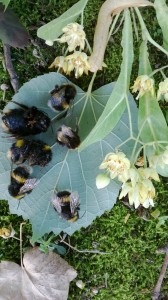A few weeks ago I was walking through the Edinburgh Garden near the foot of the Chinese Hillside when I was struck by the large number of dead bumblebees lying on the path. A closer examination showed that the bees seemed to have fallen from a silver lime (Tilia tomentosa) and formed a ring around the tree both on the grass and on the tarmac path that passed one side of the tree. The corpses were so obvious that many people were stopping and commenting.
The incident reminded me about reading of the toxic effects from the nectar of certain species of lime.
A quick bit of research online seems to suggest that not all lime trees have this toxic effect on bees. Our native small-leaved lime (Tilia cordata) and large-leaved lime (Tilia platyphyllos) are bee friendly. Indeed, lime flower honey is a product you will sometimes see for sale. Bee deaths seem to be most strongly associated with silver lime and the cultivated form of this species called weeping silver lime (Tilia tomentosa ‘petiolaris’). The problem appears to be a compound in the nectar that our native bees cannot digest.
This problem is not something to get too concerned about. Most of the bees that feed on silver lime seem to suffer no ill effects. Yesterday I was watching a weeping silver lime that was crawling with bees attracted by the heady scent. There were some dead bees, but most were actively foraging. It also seems that some bees that do get knocked out sleep off the over indulgence and live to fly another day.
The other important thing to remember is that silver lime and weeping silver lime are not particularly common trees. Botanic gardens and tree collections will often have specimens, but in parks and gardens these lime trees are rare compared to the more bee friendly native limes and the so called ‘common’ lime (Tilia x vulgaris) that is a hybrid between the native British limes.


2 Comments
2 Pingbacks